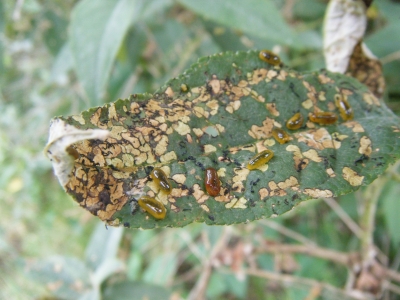Natural born weed killers
The use of insects and diseases to control certain weeds in New Zealand has been around since the 1930’s, but their potential as a realistic option for controlling weeds is only now being realised. Greater Wellington Regional Council Biosecurity Officers, Harvey Phillips and Megan Banks look at the many benefits of using biological control to keep weeds at bay.
In simple terms, biological control or biocontrol is the use of one living organism to control another. Many of the weeds causing problems in New Zealand have come from overseas, but they are not problems in their country of origin. This means insects, diseases and fungi feed on these plants in their own country. Biocontrol is about introducing those organisms into New Zealand to do the same here in an effort to keep the plants in check.
The use of biocontrol is best suited to species that are widespread, where it is not cost effective or environmentally friendly to control them with chemicals or other means. Also a widespread weed will provide the biocontrol agent with a food supply that will allow them to build up in numbers and have maximum effect.
The release of one agent to target a weed sometimes may not be enough. For some plants several agents that attack different parts of the plant including its leaves, stems, roots, and seeds may be needed to reduce its weediness. For example broom has broom gall mites, leaf beetles, pysllids, seed beetles, shoot moths and twig miners all attacking it at once, leading to an overall weakening of the plant.
Success
Biocontrol is not a quick fix solution for controlling weeds, but if you can wait, you will see a decrease in the vigour of plants with the introduction of some agents. This may take 10- 20 years for some species but others may be damaged in a relatively short timeframe. This will not suit everyone as weeds can spread quite significantly in such a long timeframe.
In some areas broom and gorse have been quite noticeably damaged by agents and are struggling as a result. Thistle agents have attacked seeds which makes noticing damage very difficult. One of the more obvious success stories in recent times has been that of ragwort flea beetle which attacks the roots of ragwort. This has reduced ragwort on farmland significantly in the Wellington region.
Up and Comers
Buddleia weevil larvae are having a good feast on this plant
Buddleia is a major weed in forestry where it often out competes young trees and makes their establishment very difficult. The initial signs of damage by the recently released buddleia leaf weevil are promising with the agents establishing readily and causing significant damage to foliage.
The effect of thistles on farms can be attributed to millions of dollars of lost productive land as well as equal amounts in chemical to control infestations. The green thistle beetle, released in the Wellington region several years ago, aims to reclaim some of these losses and all signs so far are very encouraging.
Most of the focus in the past decades has been around the biocontrol of weeds on agricultural land. However there is a shift towards finding effective agents that will attack some of the widespread environmental weeds. An increasing focus on “green” techniques for controlling weeds and a higher demand for organic produce will see alternatives to chemical control increase in the future.
Tradescantia, or wandering Willy, is a widespread environmental weed that stops anything that wants to grow through it from doing so. The recent release of the tradescantia leaf beetle that attacks the foliage of the plant is a major step forward and damage in testing has been encouraging. The release of this agent is coming soon.
Greater Wellington leads the biocontrol programme within the Wellington region with some support from Department of Conservation and district councils. Agents that are currently at work out there include those for gorse, broom, thistles, ragwort, and buddleia. These are released and distributed around the region when numbers are large enough. For more information contact the Biosecurity Department at Greater Wellington Regional Council on 0800 496 734 or pest.plants@gw.govt.nz

